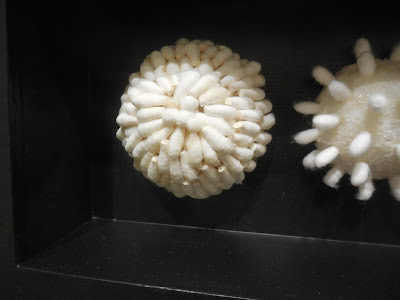Have I saved the best for last? I love hand stitching, and am always happy to see plenty of it in a fiber art show.
Susan Moss, Yes It's Been a Long Time (details below)

The warm background tones were put on with dye and fabric paint; the line drawings are stitched. I love the jittery line of the stitching, making wonky pitcher and glasses. I love the doodles at right and left, mystery marks that we don't understand, and the lettering at center that requires decipherment. Not sure why the artist has let the text disintegrate; perhaps the speaker doesn't really want to share that sangria...
Diane Siebels, Untitled (detail below)
Just when I got to be able to recognize a Siebels quilt from the other side of the room (I've seen several of her huge profile heads in various shows over the last few years) she pulls a new technique out of the hat. This is a whole cloth quilt, the design entirely applied with long hand stitches in heavier cotton and wool -- yes, even the roses, thorns and owl on the outer panels. Hard to say if I like it better up close than from farther away; the imagery is subtle from afar and exciting in close-up.
Roz Ritter, The Great Unknown (detail below)
This is a picture of the artist in sixth grade, printed on several sheets of kozo paper and hand stitched. I like the contrast between the blurry photo and the crisp stitching, outlining the plaid of her dress. I'm not so sure about the overall presentation; is it a bit too casual, raggedy at the edges and simply pinned to the wall? Do those hanging threads hang a bit too long, drawing the eye out of the scene and down to the floor? Oh well, just look at the detail shot and fall in love.
Amy Meissner, Inheritance (detail below)
Meissner is well known for working with old textiles; here she started with an unfinished needlepoint panel and extended it into a large quilt with a timeless motto. As a lover of repurposing beat-up and abandoned textiles myself, I thrill to this piece.
I love the fact that the original stitcher apparently ran out of beige yarn and finished up the southwest corner in pink, and that the canvas got all rhomboid with stitching; I love the manufacturer's ID stamped on the bottom of the canvas (can you see it? "Hiawatha Heirloom Super Canvas"). I like the way the new stitching blends with, yet contrasts with, the original.
I'm a little confused about the cranky cri de coeur; is she addressing the original stitcher who left this pathetic UFO for somebody else to rescue? Or is she addressing her husband and kids or sloppy officemates? Despite the ambiguity, or perhaps because of it, maybe this is my favorite piece in the whole show.
The show, sponsored by the Surface Design Association, continues at the Schweinfurth Memorial Art Center in Auburn NY through August 21.






















































